Authors: @TianranZhang, @fangtingeth, @_eat_apple_, @0xBrawler
A Song of Ice and Fire on the Chain
“What is dead may never die, but rises again, harder and stronger!”
– A Song of Ice and Fire
In just two short years since its birth, Loot has interpreted a blockchain version of “A Song of Ice and Fire”. In the initial frenzy, nearly 300 derivative projects formed a Lootverse. After the cooling off period, the Lootverse community receded, leaving behind a group of core members with true creative enthusiasm, who managed to preserve the spark of the story and survive through crises such as Luna, FTX, and other deep bear markets with minimal expenses. Time has proven that a good story never dies: in the early spring of the metaverse, dojo reignites the spark of Loot, and the derivative projects of Lootverse regain vitality, experiencing a significant increase in both quantity and quality of creations.
- What important role does the on-chain programmatically generated NFT map Crypts and Caverns play in Lootverse?
- Virtual avatar is the canvas of digital assets, but NFTs are optional.
- An overview of Hashed, a top-tier cryptocurrency fund in South Korea more than 130 projects, with a focus on gaming and infrastructure.
The harsh winter has passed. On the eve of the revival of Lootverse, let us reread this “Eternal Story”. This article will cover three aspects: the origins of Lootverse, the evolution of Lootverse IP and ecosystem, and why Lootverse is the best existing story in the metaverse.
The Origins of Lootverse
Two years ago today, on August 28, 2021, Lootverse was born. Within ten days, the price of Loot soared to a staggering 20 ETH. Behind the price was a series of value propositions that appealed to everyone, such as the bottom-up nature of Lootverse, the decentralized team, and the use of “txt NFTs” instead of rich media NFTs. These innovations pushed the boundaries within the “crypto native” standards. A few lines of black text on a white background served as a “prompt” for a complete world system. Everyone found their own imagination of a “composable world” through those few columns of nouns, and went beyond imagination: Lootverse was completely open in its mechanism, allowing everyone to truly participate in the process of “collaborative world-building”.
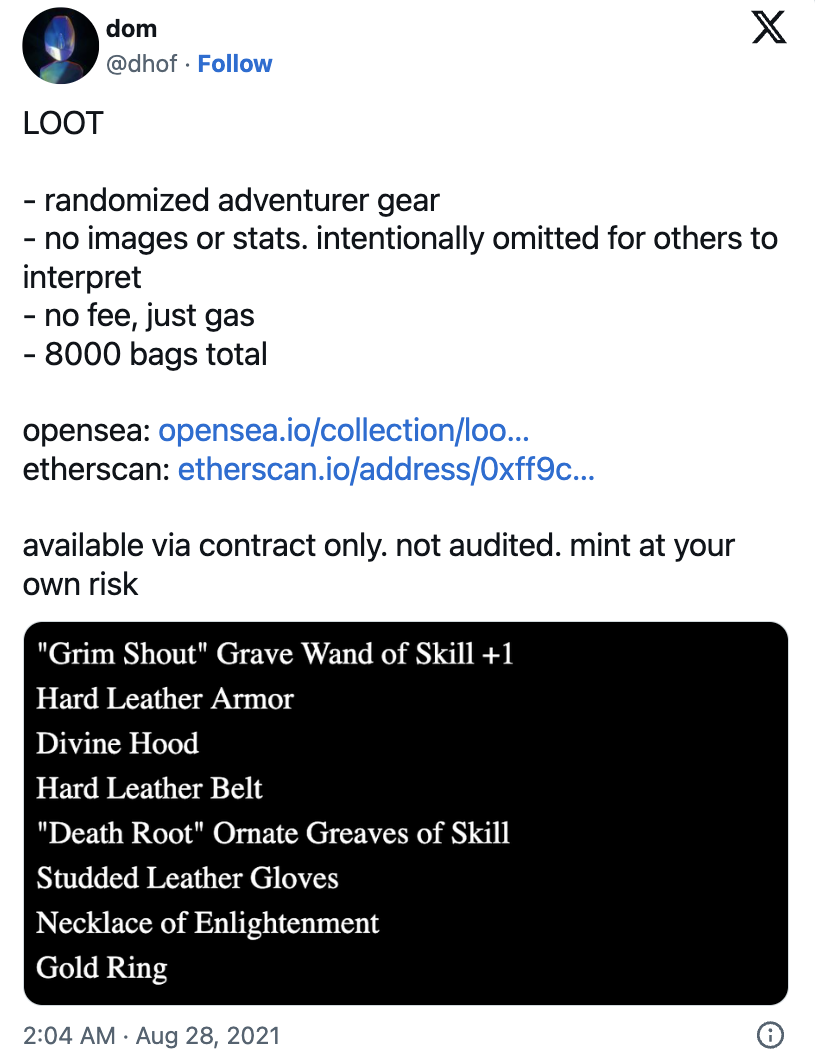
Early History: The Rise of Derivative Projects
An entirely open story universe combined with a freely tradable market resulted in a thriving group of derivative projects. Within three months, nearly 300 derivative projects emerged in Lootverse. While most of them were speculative works, there were also many original creations.
The Genesis Project, initiated by Timshel (also the creator of Loot.foundation), was one of the important derivative projects. It restructured the original Loot bags and allowed holders to extract Genesis Mana based on the suffixes of Loot, awakening Genesis Adventurers. This collectible card upgrading game cleverly mobilized the community, requiring collaborative communication among community members and driving everyone to have more creativity and familiarity with the meta timeline of Loot. The timeline compilation of DivineDAO was also completed during this time. In this newly developed narrative context, there were a total of 2540 Genesis Adventurers NFTs, and naming rights were also made available.
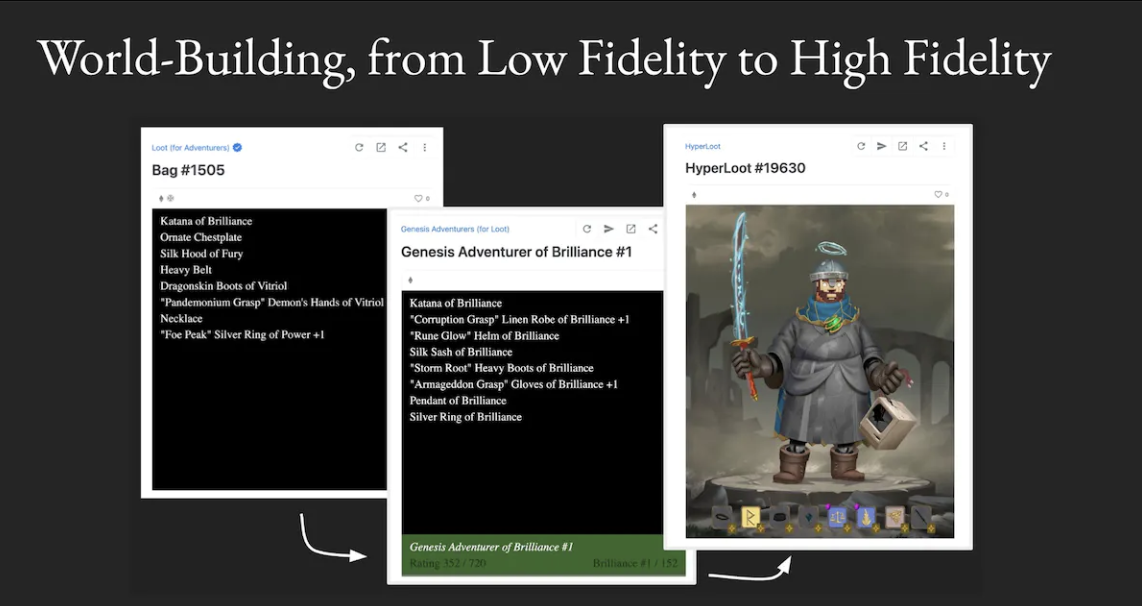
Genesis Adventuer and Hyperloot game screenshots
The naming open allows GA to have the potential of “universal IP”, which allows a character to be named Ned Stark or Jon Snow, creating true character prototypes in the Lootverse. Subsequently, the Genesis Scroll storytelling contest attracted considerable attention, piecing together the Lootverse of “Game of Thrones”. Dylan Field, the founder of Figma, was one of the earliest contributors to the Genesis Scroll project.
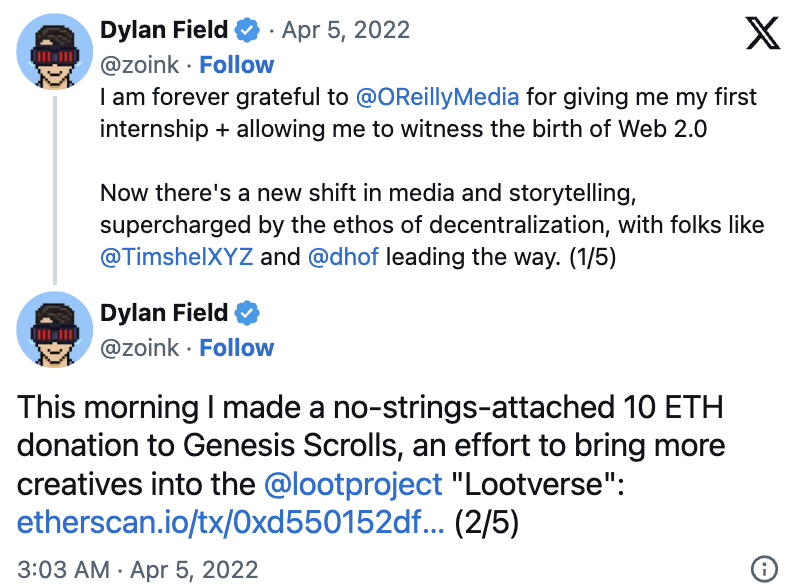
Hyperloot is a derivative project of Loot, presented visually from an artistic perspective, contributed by an excellent team from Thailand, with a clear roadmap and product quality, connected to other Loot ecosystems such as mloot, Genesis Project, and CC0 projects like Nouns, Chain Runner, and Blitmap. With the release of 3D NFTs in 2023 and its own spin-off games, Hyperloot is still worth paying attention to. Even LianGuairadigm and Coinbase co-founder Fred Ehrsam have made great efforts to depict the efforts of the Hyperloot team in the CC0 war, similar to “Marvel Heroes VS Capcom.”
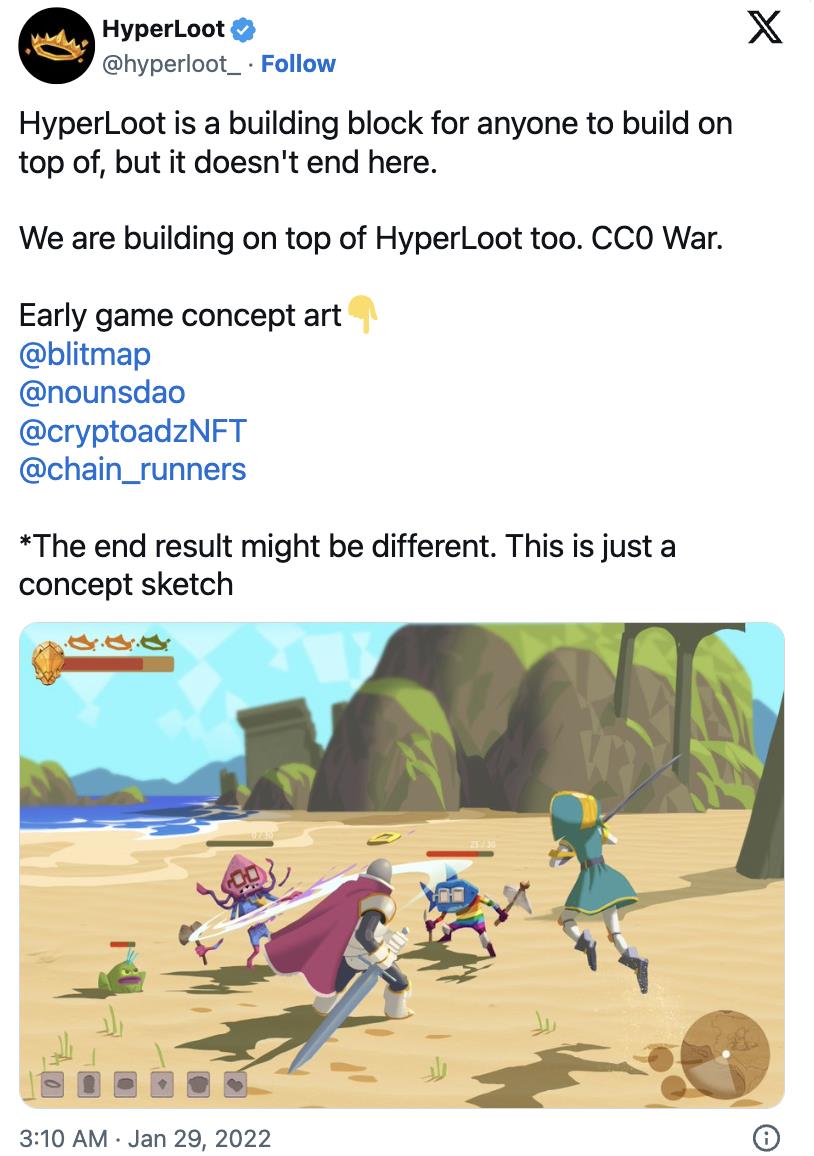
Crypts & Caverns is another important on-chain infrastructure in the Lootverse, created by threepwave in November 2021, providing composable dungeon maps. As a universal map, Crypts & Caverns is not only available within the Lootverse but will also be handed over to CheDAO for management in 2023. For information about CheDAO governance, please refer to “Crypts and Caverns: A Sleeping Giant Awakened by CheDAO”.
The Crypt is a Loot-based underground dungeon exploration game designed to acquire imprisoned NFT relics. Players need to hold Loot, mLoot, or GA to participate in the game, which has three open chapters. This is the first fully playable on-chain Loot game. After receiving $4 million in funding support, the Playmint team started building their own on-chain game.
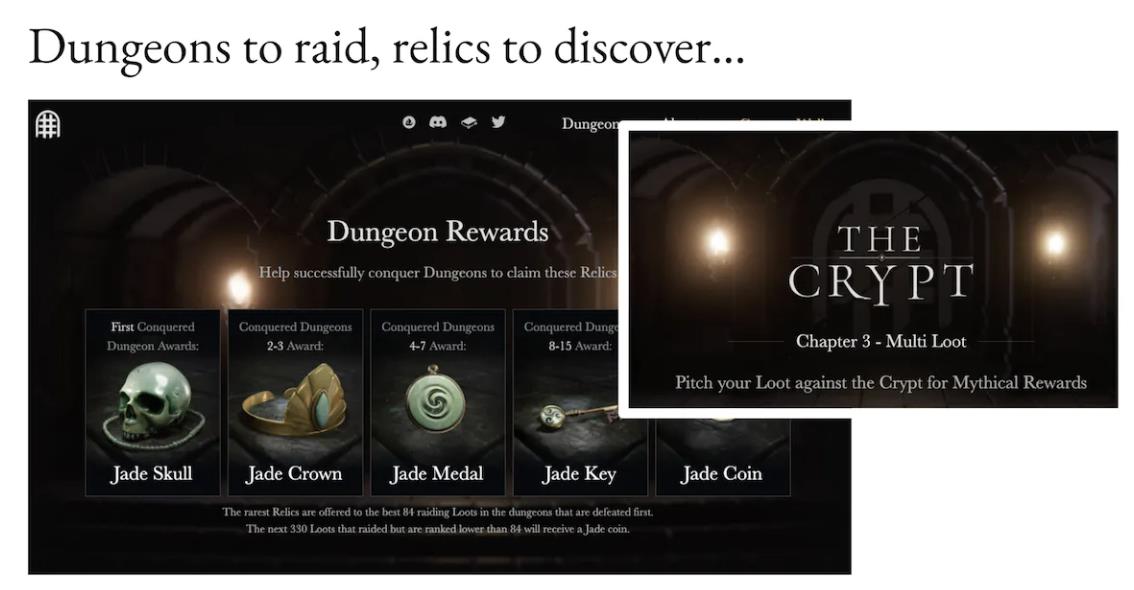
Adventure rewards in The Crypt game
Loot Realms is a series of 8,000 programmatically generated NFTs developed by BibliothecaDAO. Realms is one of the core organizations in the Loot ecosystem, maintaining stable productivity and subsequently releasing its own governance token $LORD by staking Realm NFTs. Unlike other games, it has chosen Starknet as its game landing destination. The first game it decides to build is a strategy SLG game called Eternum. More on this will be discussed later as Realm has proven to be the sole pillar of the Lootverse today.

Realm NFT and early Realm: Eternum game screen
Dope Wars is a completely StarkNet-based on-chain Loot-style game, initiated by perama in August 2021 and thriving with contributions from the Cartridge team. Inspired by “Drug War” and “GTA,” it integrates street culture into a “GTA” style universe. The game’s first playable mode, “Roll Your Own,” adapts “Drug War” to the StarkNet L2 layer. As an important Loot derivative project, “Dope Wars” and “Loot Realms” started on the Ethereum mainnet on August 31, 2021, and distributed 125,000 $LianGuaiPER tokens to NFT holders on September 4th. The Cartridge team is currently developing Dojo, a StarkNet on-chain game engine, which will be introduced in the second half of the article.
2022 Grant Program Driving the Community Ecosystem
Until the end of 2022, the Lootverse community ecosystem is still thriving under the contributions of its core creators, hosting more than 30 community meetings; Timshel’s milestone Loot Deck released in April 2022 is still resonating in the community and serves as the “North Star” of Lootverse in a practical sense.
The initial hype has cooled down, with an estimated 300 Lootverse derivatives created in the first three months, most of which quickly disappeared. However, about 10% of genuine projects still exist and new projects continue to emerge throughout 2022. By mid-2022, there were estimated to be around 30 projects, most of which relied on self-funding or grants.
From eight lines of text on a black background to an interconnected network of projects, these projects together form an infinitely expandable yet cohesive sci-fi fantasy universe that drives the development of Lootverse.
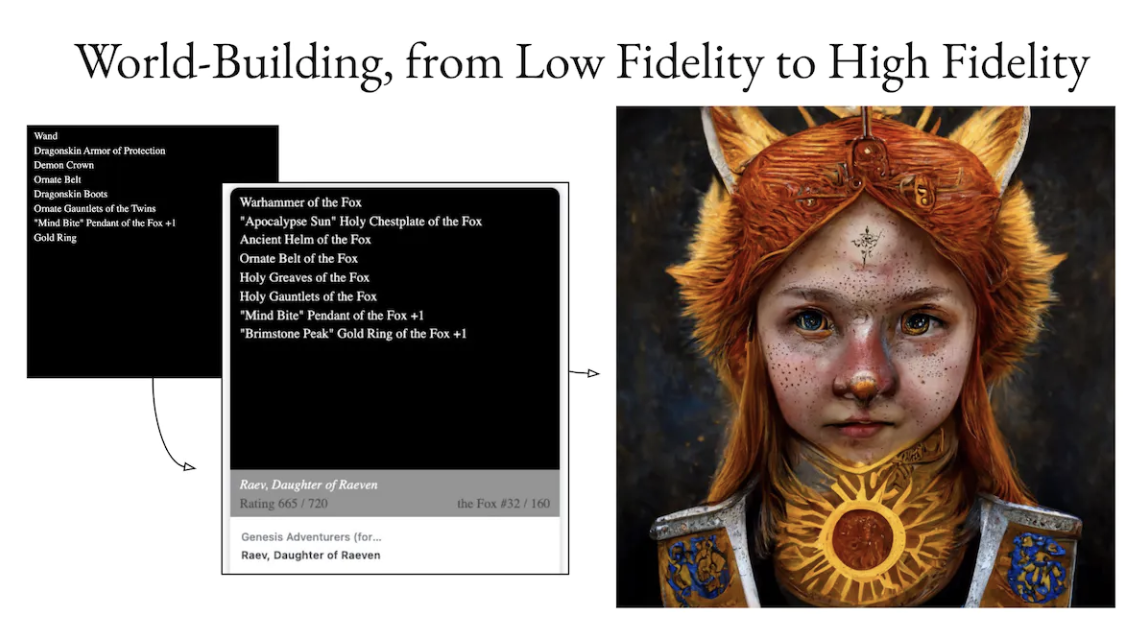
Artifacts specifically created for GA on the right side
Gitcoin has been a stable partner in nurturing the Lootverse through regular funding opportunities. In grant rounds 14 and 15 in June and September 2022, Gitcoin provided over $200,000 in total funding for the Loot ecosystem. Round 14 included support for “Monsters of Realms,” “The Violette of Vitriol” project, “Genesis Scrolls” (involving the creation of stories, character backgrounds, and creative content set in the Genesis Scrolls era, with the first Genesis Scrolls round held in June 2022), and “The Genesis Scrolls LianGuaiinted” (these projects have a strong “Game of Thrones” or “Lord of the Rings” feel). In September 2022, Gitcoin’s round 15 grant provided $75,000 in funding support for 21 projects expanding the Loot ecosystem. With a total of 1,162 donors contributing over $92,000, the total funding exceeded $84,000, providing timely support for a broader interest in NFTs.
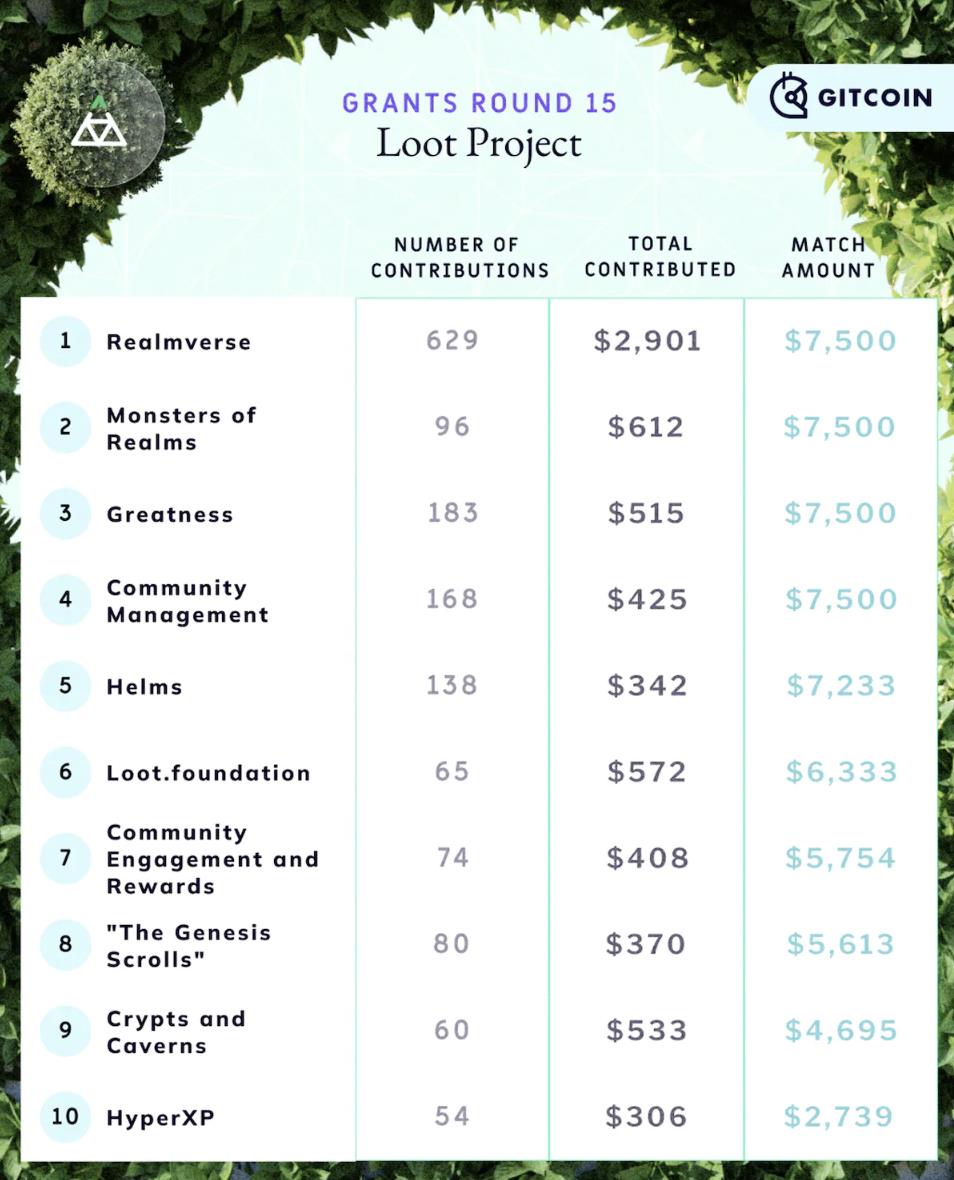
Lootverse, a project in the 15th round of Gitcoin
Mask Network has also increased its support for Lootverse, supporting 5 key projects. In their first batch of grants in November 2022, beneficiaries such as Genesis Scrolls and The Rift received $10,000 each to advance narrative and gaming infrastructure. In the second batch of grants in June 2023, Dojo received $20,000 to further develop its StarkNet game engine, Guildly received $10,000 for NFT guild functionality, and Banners received $10,000 to move its text RPG onto the blockchain.
The strategic grants provided by Gitcoin and Mask at a critical moment demonstrate their commitment to maintaining the community-driven ecosystem of Lootverse. These funds help projects overcome market fluctuations during the crypto winter and continue to build.
One notable grant is the Genesis Scrolls project, which is used to attract writers to bring Lootverse into real life. In less than 6 months, it attracted nearly 100 entries, totaling about 100,000 words. Subsequently, a professional editor was brought in to turn these works into a complete Loot book, which is expected to be published soon.
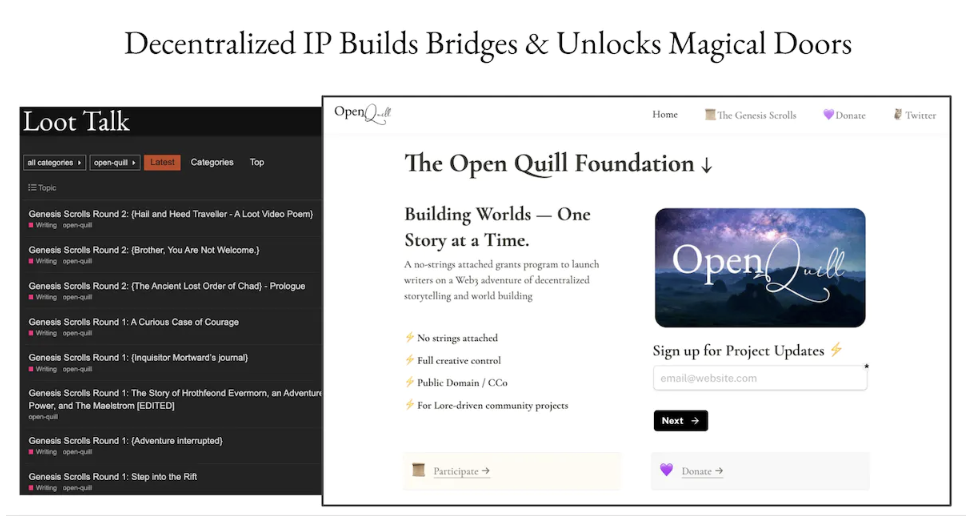
You can also read this article to learn about the situation of Loot one year after its birth.
Loot, One Year Later: The NFT Hype Is Dead—But ‘Lootverse’ Hope Lives On – Decrypt
Realms – The Culmination of the Game
If Timshel’s Genesis Adventurer and Genesis Scroll are projects that link Lootverse at the legendary level, then Loaf’s Realm is uniting Lootverse through products, especially a set of games.
Prior to the release of the game, on February 21, 2022, Realm showcased the first version of Realm Atlas, which aims to showcase the upcoming content. This exhibition was stunning.

The Realm Atlas
This image shows the Atlas, which contains 16 Orders (countries) such as FOX, Power, and Giants, all generated based on Loot data. It is similar to the complex political landscape in “Game of Thrones”. NFT projects like Realms, Loot, Genesis Adventurers, Crypts, and Caverns correspond to these countries in the Atlas.
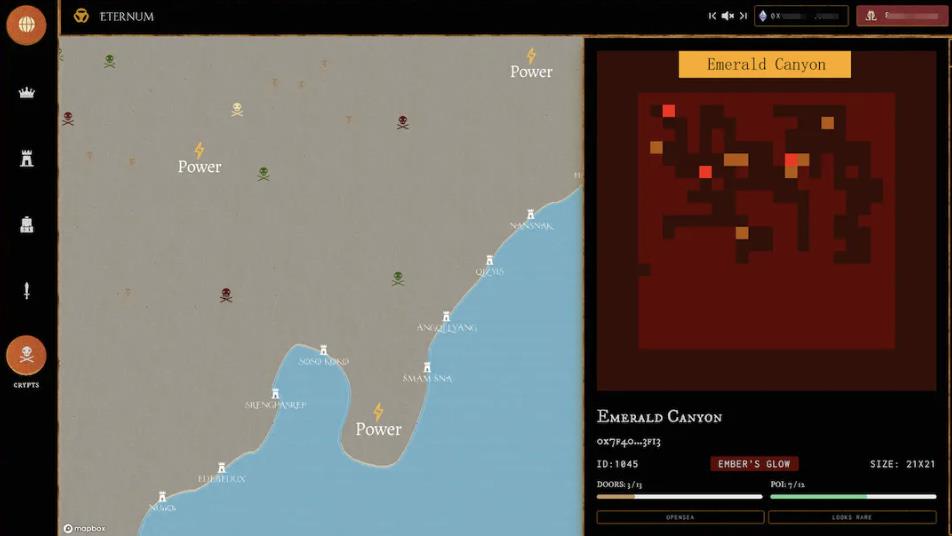
C&C in the Atlas, each skull represents a C&C plot
Later on, the Atlas underwent several evolutions and added some features, such as viewing your four main NFT packs and flying to your territory. It also provided much-needed solace during the long wait for the main game Realm: Eternum’s development.
Realm: The pre-alpha version of Eternum was released in January 2023, presenting a complete experience where players can exchange resources, form armies, build castles, and wage wars, among other things. The game is still rough around the edges in some aspects, but the gameplay is already in place.

First version of Realm Eternum
A few days after the release of the pre-alpha version, the Realms team launched a $625,000 financing round to the community. Within 24 hours, they received commitments for $4,000,000, surpassing the over-subscription rate astonishingly by 6.32 times (5.32 times has been refunded), reflecting the community’s strong confidence in the growth of Realms.
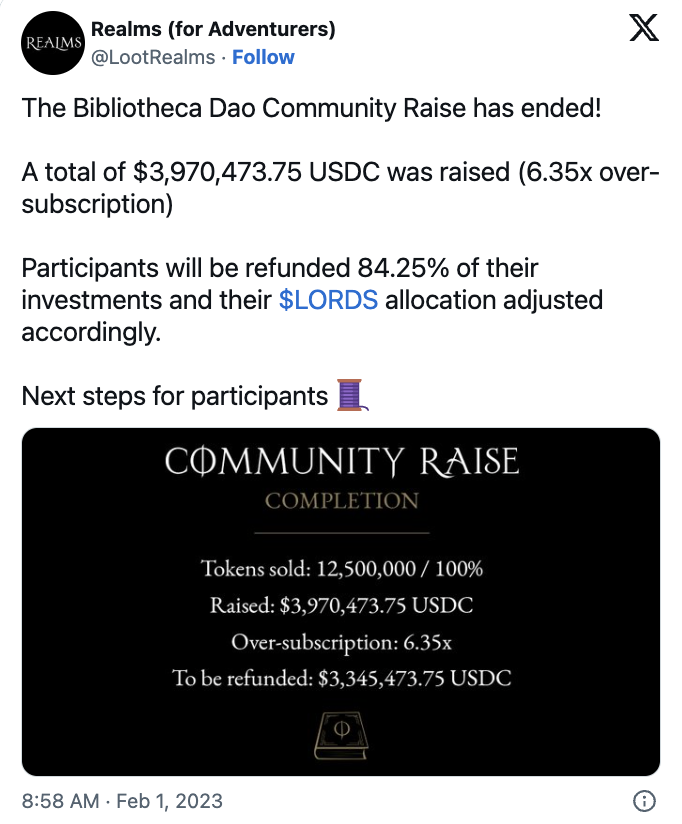
However, with the impact of a series of market crashes and other reasons, it has become difficult for most community projects to survive the deep crypto bear market. By the spring of 2023, only 5 out of approximately 30 Lootverse projects are still active. Nevertheless, spring is approaching.
Entering the DOJO Era – The On-Chain Game Engine Built by Cairo
Building games directly on the blockchain is a huge challenge, as pioneers like Dark Forest and Realm Eternum have discovered. The first version of Realms: Eternum testing clearly showed two things. First, a dedicated game framework or engine is needed to facilitate game development. Second, a simpler game is needed to enrich the domain world and enter the market faster. The first requirement confirmed the significance of Dojo, while the second requirement propelled us towards Loot survivor.
Thanks to the Lattice team for creating MUD in early 2022, which ultimately solved this problem and later introduced the concept of autonomous worlds, all of which have been highly successful. Dojo initially started from a Telegram group consisting of members from the realm, cartridge, and briq teams. It was originally created on StarkNet as the MUD v1 branch in November 2022. With the investment of development resources, Dojo has far surpassed its initial conception.
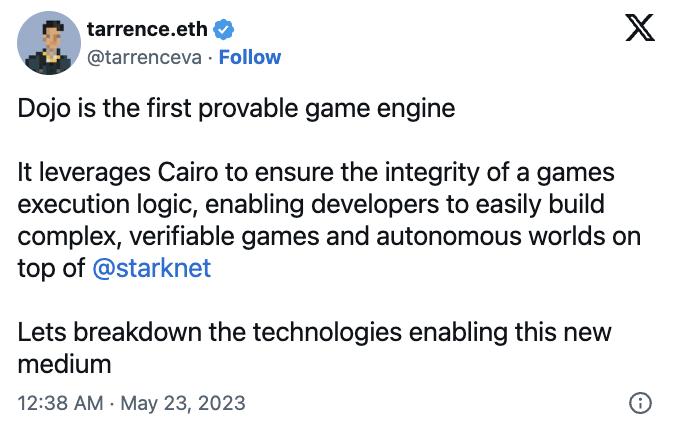
Dojo Engine is a public game engine built by Starknet developers. It is the only verifiable game engine on the market, and verifiability has largely inspired the architecture and tools built for game engines.
Dojo provides developers with an Entity-Component-System (ECS) architecture and integrated tools tailored specifically for Starknet and Cairo development. This open-source engine lowers the barrier to creating high-quality on-chain games with true ownership and asset interoperability. By fostering a strong community, Dojo aims to drive innovation and surpass the achievements made by MUD on the EVM.
Loot Survivor is a text-based adventure game created by Bibliotheca DAO on Starknet. It leverages the procedural generation elements of Loot to allow players to adventure in dangerous realms filled with monsters, traps, and bosses. The goal is to rank high on the leaderboard before your character perishes.
This game cleverly implements the Play2Die economic model, where tokens are carried and dropped upon the death of a character, compensating early adopters and incentivizing participation. Over 500 on-chain characters have already been created.
Loot Survivor showcases creative on-chain game design and community involvement. It is built on StarkNet using Cairo, maintaining full on-chain functionality while keeping gas costs low. Although the current interaction speed is slow, Ethereum improvements like EIP-4844 will enhance StarkNet’s performance and reduce the cost of on-chain games.

Level 20 game item in Loot Survivor
It is worth noting that the items and digital designs in the “Loot Survivor” game align with the original Loot and GA settings, as the game’s design is led by Loothero. This strong inheritance brings back memories for die-hard fans of Loot, allowing them to revisit the early Loot frenzy in the later stages of “Loot Survivor.” Sacred robes, warrior swords, +1 attributes, and 16 ranks, they have it all.
The Rise of Dojo and Loot Survivor: Realms Members and Starknet On-Chain Game Team Pushing Forward at Full Speed
The on-chain game summit held in Portugal from May 25th to 26th became a milestone for the Loot and Dojo ecosystems. Among the 50 participants at the summit, 6 were from Realm, 4 from Cartridge, and 2 from briq, accounting for a quarter of the attendees. In the three days before the summit, Tarrence’s announcement about Dojo garnered wide attention and recognition in the Starknet and Ethereum communities. Polynya stated that the infrastructure created for on-chain games will usher in a new paradigm and lead to broader application layer innovation. The Dojo demonstration on the first day of the summit was also successful and received strong community support. On the second day, during the designated game testing period, Loot Survivor made its first appearance from an internal alpha version, and it happened to be the only playable game at the time. Despite the poor performance of Starknet, with operations in the game taking 3 minutes, the leaderboard system incentivized those eager to win to climb the ranks, and the bounty constantly updated as people quickly broke each other’s records, eventually reaching a bounty of 0.1 ETH. This mechanism proved to be successful.
As Dojo matures as a technical infrastructure, more and more games are starting to appear on Dojo. (The first version of Loot Survivor was built directly on StarkNet, not on Dojo. Two hackathons were held in June and July, and pixellaw became a wonderful addition to the Dojo family. Initially, it was just a brainstorming session at the Komorebi Hacker House in Paris.
Both Dojo and Loot Survivor have become key initiatives in the Loot ecosystem. They highlight the potential of StarkNet in achieving an on-chain gaming experience.
Early games like Influence, Dope Wars, and Realms demonstrated the potential of Dojo. As the first game engine designed from scratch for StarkNet, Dojo laid the foundation for the next generation of crypto games. Its open and scalable nature will allow the engine to evolve continuously as StarkNet matures. Dojo represents a key milestone in delivering on the promise of blockchain gaming.
The Rebirth of Crypts and Caverns
Crypts and Caverns (C&C), a groundbreaking program-generated map NFT project, has recently been acquired by CheDAO, marking an exciting new era for C&C. C&C showcases its adaptable mapping capabilities and has tremendous potential. However, progress has been stagnant in recent times. With CheDAO taking over C&C, new momentum and scalability are expected.
CheDAO plans to optimize C&C as a flexible mapping module for developers. Through partnerships, the goal is to drive the adoption of C&C as the standard for random maps in on-chain games. This aims to make C&C widely used in games that require programmable environments.
C&C is ready to unleash its tremendous potential by integrating with various games like Lootverse, showcasing its versatility, and will continue to focus on community involvement in the future. C&C injects a bright future into community-driven innovation in on-chain gaming. The integration progress across game universes will demonstrate the adaptability of C&C’s mapping capabilities.
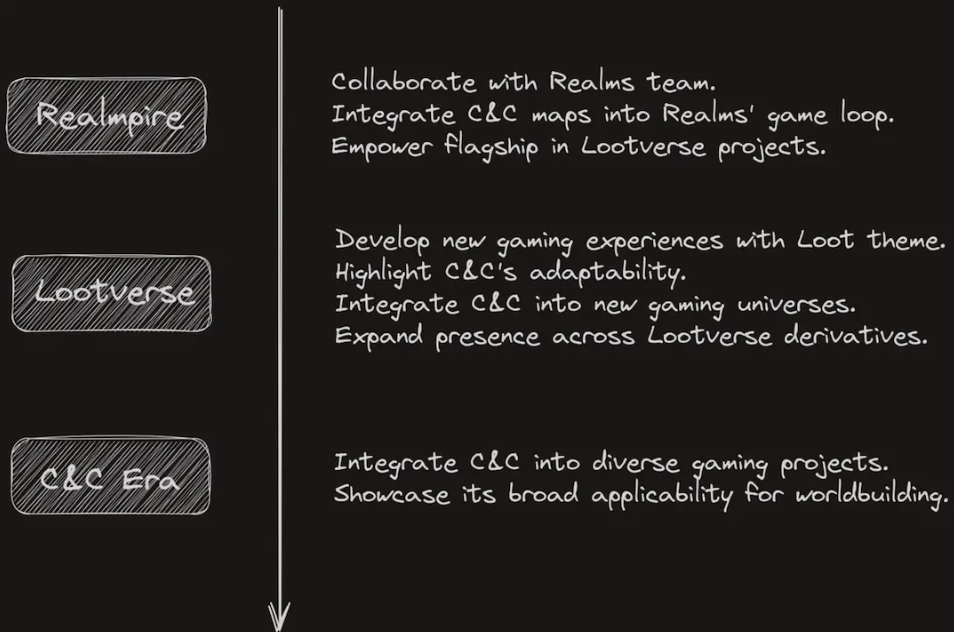
Crypts & Caverns New Roadmap
Frontinus House: A Grants Distribution Platform
Realms Autonomous World (RAW) aspires to truly live up to its name: autonomous. However, this autonomy depends on the existence of infrastructure, commonly referred to as public goods. This understanding gave birth to the concept of Frontinus House, a way to deploy capital and fund projects within RAW and the broader Loot ecosystem.
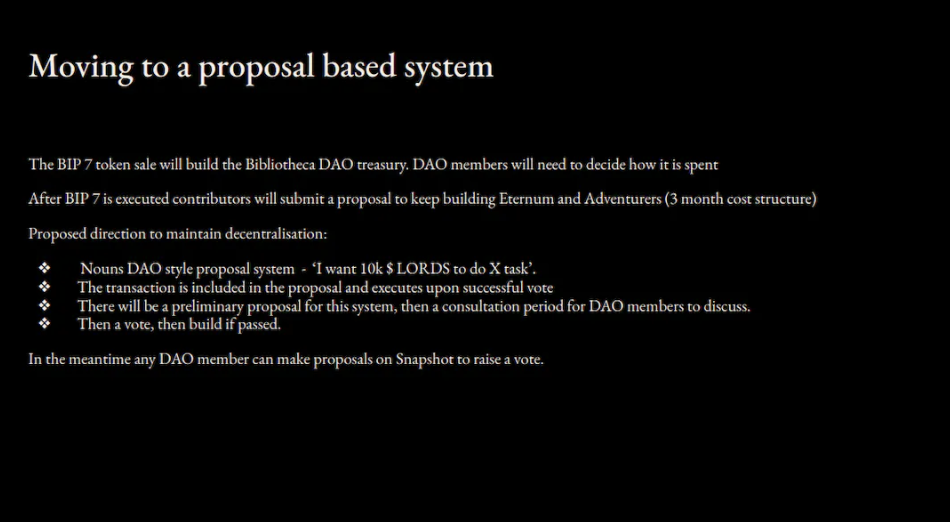
Frontinus House officially launches after the BIP7 proposal
Frontinus House will kick off during the fundraising phase, during which builders will present the most innovative and compelling project ideas resonant with the vision, mission, and goals of Loot Realms.
The ultimate goal of Frontinus House is to foster a transparent, accountable, and collaborative culture in the use of public capital. It also aims to support the development of excellent public infrastructure that adapts to community needs. By doing so, RAW aims to realize its vision of autonomy, promote transparency and collaboration within the Loot ecosystem, and provide the necessary support for community-driven projects and infrastructure development.
Empowering Realmpire: Overview of Realms Grant Project
With Frontinus House ready, the first round of Realm grant applications has begun. The 24 thoughtful proposals received for the Loot Realm Genesis Grant recently demonstrate the revived interest and engagement within the Lootverse ecosystem, marking its recovery from a stagnant year. During the passionate period following the release of Loot, nearly 300 derivative projects entered the stage, mainly focused on cultural and creative projects, collectively forming the Lootverse. However, by mid-2022, only about 30 projects primarily centered around cultural and creative pursuits survived the initial enthusiasm.
After another year, only 5 out of these 30 projects remain active, reflecting a decline in momentum. However, a significant shift occurred with the introduction of the Dojo game engine on Starknet. This engine lowers the barriers for developers and opens the door for a new round of projects, especially in the gaming and interactive experience fields. As a result of this transformation, a new wave of 24 proposals has been approved through the Realm Grant. This new wave of projects is mainly related to gaming, leading to the resurgence of activity in the Lootverse and raising the number of currently active projects to approximately 30. From 300 creative projects to 30 cultural survivors, and then down to only 5 active initiatives, we have now returned to a diverse set of 30 projects, fully embodying the dynamic journey of the Lootverse ecosystem.
The renewed vitality and transformation of gaming-related projects are closely related to the rise of the Dojo game engine on Starknet. By providing a powerful and user-friendly platform for game developers, Dojo has sparked a creative landscape within the Lootverse. Combined with the organic momentum of the Lootverse, this signifies a welcome spring after the cryptocurrency winter.

24 projects in Realm Grant Applications
In the past year, the resilience demonstrated by the fluctuating fortunes of the Lootverse highlights its deeply rooted nature. With the resurgence of this vitality and a strengthened foundation, Lootverse is ready to move towards the next phase of decentralized world-building, showcasing the vibrancy of a collaborative ecosystem built on open infrastructure (Loot).
Recent news confirms the formal approval of BIP-14 proposal. The number of eligible grants has increased from 5 to 10, indicating the Realms community’s considerable confidence in promoting the ecosystem.
BIP-14: Increase Frontinus House Proposal 1 Grants to 10
Why We Are Optimistic about Lootverse and Dojo Game Engine
Lootverse nurtures a vibrant ecosystem through the combinatorial and interoperable nature of its core NFT primitives. Projects like Realms, Loot, Genesis Adventurers, and Crypts & Caverns have established reusable building blocks, making collaborative world-building seamless. This modular approach lowers barriers for developers and creators to participate. By encompassing shared infrastructure such as maps, items, and characters, Lootverse empowers the power of imagination to flourish.
On the narrative level, Lootverse demonstrates the potential of decentralized storytelling. By designing narrative techniques that inspire creativity, the community has collectively built a complex world. This decentralized model resists integration under a single vision and instead fosters a variety of perspectives. Lootverse showcases how blockchain enables a permanent, open-ended story shaped by collaborative participation.
As a complement to the rich world-building assets, Dojo provides a powerful technological foundation as a game engine tailored for blockchain capabilities. Dojo’s architecture, based on recursive proofs, incremental verification, and compressed state storage, opens up new realms in on-chain gaming. Combined with Cairo’s performance, versatility, and Rust-like advantages, Dojo establishes a development environment that unlocks gameplay complexity far beyond current limitations.
With strong fundamental components on the narrative, economic, and technical levels, Lootverse and Dojo have tremendous potential. As interoperability building blocks accumulate and tools mature, their momentum becomes unstoppable. We are witnessing the birth of a new creative paradigm that will reshape the way collaborative digital worlds are constructed. When imagination and innovation converge, the possibilities are limitless.
Lootverse and Dojo have laid the foundation for the next generation of community-driven game universes. As spectacular things unfold, it is evident that this is just the beginning.
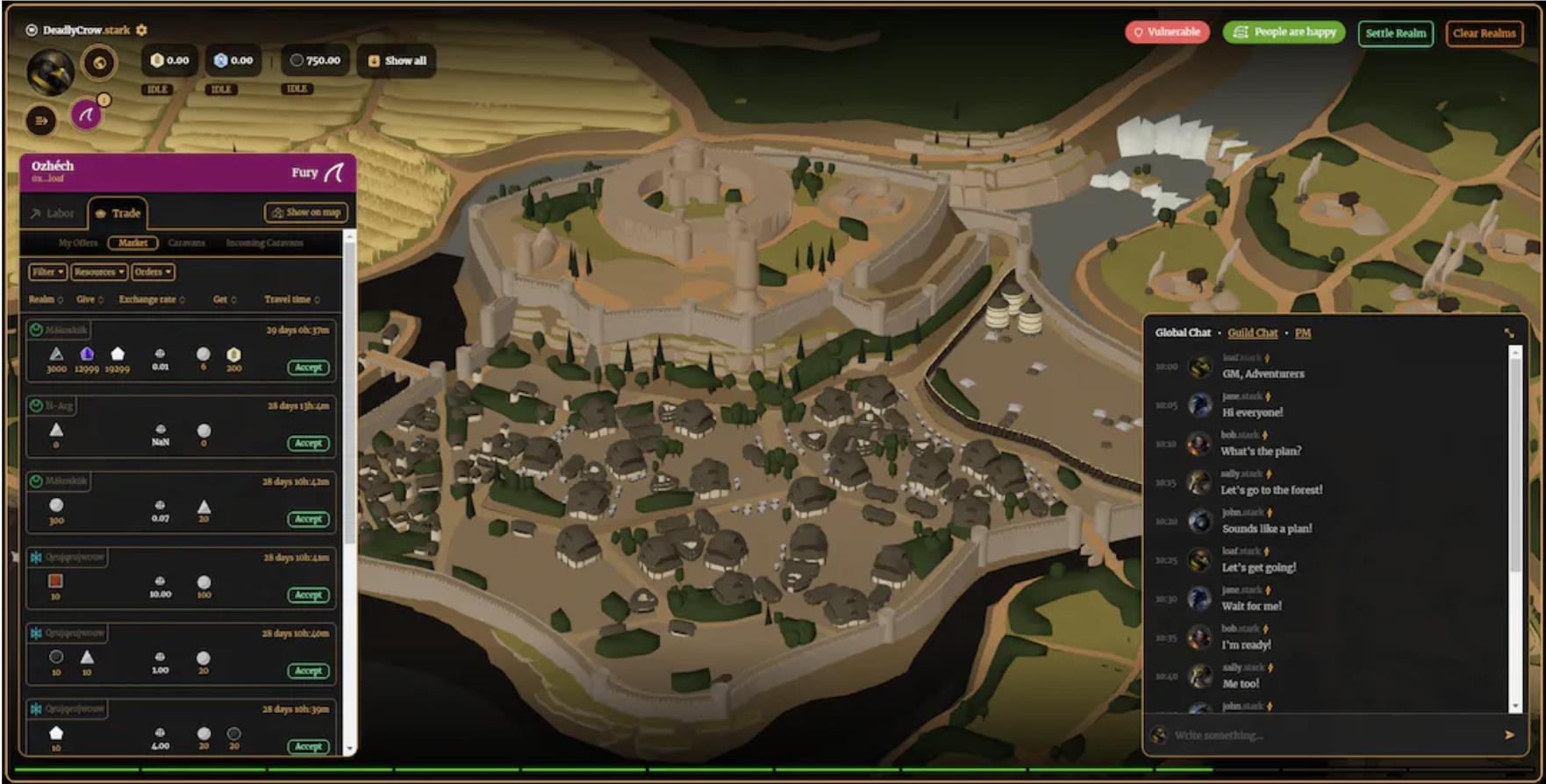
Realm Eternum redeveloped using the Dojo engine
The Role of Asian Developers and Reasons to Be Optimistic about the Asian Community
Lootverse offers a reminiscent Asian game theme, such as the fantasy sandbox inspired by the Three Kingdoms. In China, Three Kingdoms games occupy nearly 10% of the gaming market, ranging from role-playing games to multiplayer online battle arena (MOBA) games and more. “Honor of Kings,” the highest-grossing game globally, even has over 20% of its characters from the Three Kingdoms era.
The resonance of the Three Kingdoms culture throughout Asia can be seen in Lootverse’s global appeal. As Lootverse expands, Asian developers, especially those from China, can replicate the successful formula from Three Kingdoms games. With strong productivity and successful templates, Asian teams are expected to launch related Lootverse games, potentially capturing over 10% of the on-chain gaming market share and achieving popularity comparable to blockbuster games like “Honor of Kings.”
Their familiarity with the broad appeal of story-based game universes will be invaluable. Observing the thriving ecosystem in Asia, global creators will be attracted to participate in Lootverse. Their collaborative contributions in technology, content, and operations will complement each other, restoring Lootverse’s original decentralized spirit.

A screenshot from the demonstration of the Starknet Astro Workshop held by Loaf in Chengdu. The event once reached 100 participants.
With its narrative resonance and composable basic elements, Lootverse may become the next breakthrough game paradigm driven by the Asian developer community. Their expertise plays a crucial role in guiding Lootverse towards true decentralization and diversity. By linking global creators, the Asian team brings us closer to a collaborative narrative on a metaverse scale.
Like what you're reading? Subscribe to our top stories.
We will continue to update Gambling Chain; if you have any questions or suggestions, please contact us!